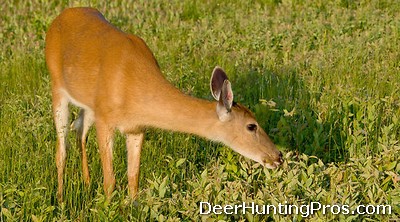Whitetail Deer Nutrition for Management, Improved Hunting
The nutritional requirements of white-tailed deer vary by age, gender and season. A deer’s diet can change based on many variables, but the bulk of the studies on whitetail deer nutrition has focused on protein, energy and the two most important minerals for body and antler growth, phosphorus and calcium. Changes in the nutritional requirements of whitetail that occur with gestation, lactation, breeding and antler development should correlate with seasonal changes in nutrient availability from forage plants. What deer eat depends on what is available, but it also depends on what they need.
An increase in whitetail deer management across the United States spurred widespread research to identify limiting factors in deer foods. When it was all said and done, the nutritional requirements of whitetail deer are generally separated into protein, energy, minerals, vitamins and water. These five groups comprise a deer diet.
Protein is critical for body growth in whitetail, particularly for fawns and yearlings. Insufficient protein intake in a given year will also reduce antler growth. In fact, a period of inadequate nutrition (low protein) for buck fawns may adversely influence antler development for several succeeding years, maybe even for life. A whitetail must obtain at least a six to seven percent crude protein diet to maintain rumen function, but a protein diet in the 13 to 16 percent range is required for successful growth, antler development and reproduction.

The energy requirements of whitetail deer have not been specifically identified, but energy demand is impacted by weather conditions and the physiological state of deer. Energy deficiencies can result in cessation of growth, weight loss, reproductive failure and impaired rumen function. Most nutrition research whitetail deer forage quality has primarily focused on protein and mineral levels of food plants, not on energy content.
Recent dietary research has included a qualitative measurement called dry matter digestibility (DMD), a measure closely related to digestible energy. DMD is a good indicator of digestible energy for most plants, so has merit when talking about deer nutritional needs. Data indicates that adult whitetail require foods with a DMD level of of 50 to 55 percent, which rises to approximately 65 percent for does with fawns.
Minerals are quite important for grow deer, so much of the research on deer mineral requirements have involved fawns. There is a lack of information available on requirements of adult whitetail, specifically for maximum antler growth in bucks. That said, a phosphorus (P) intake level of approximately 0.35 percent is necessary to provide maximum weight gain, bone growth and antler development in yearling bucks. During much of the year, few plant species contain phosphorus levels that high.
As such, phosphorus may be a limiting nutrient across much of the whitetail’s range for maximum antler growth. Diets containing 0.40 percent calcium and 0.28 to 0.30 percent phosphorus are required for acceptable growth and development in deer. Most pelleted protein deer feeds contain the necessary amounts of these nutrients, but always check the labels if you are concerned about ideal deer nutrition. Other minerals, such as sodium, potassium, chlorine, zinc, iron, and magnesium, are important, but most are typically supplied by plants in the areas deer inhabit.
With regards to whitetail deer, little research has been conducted on vitamin requirements. The most important vitamins for deer development are vitamins A, D and E. Vitamin A is especially critical for antler growth as ossification (hardening) occurs. Whitetail have the ability to convert carotene in green leaves into vitamin A, which then becomes available for a variety of body functions. During much of the year, carotene intake should be more than sufficient, but minor vitamin-A deficiencies may occur during harsh, dry winters.
Vitamin D is important in deer, as for other species, for promoting calcium absorption and the mineralization of bone. Vitamin D requirements are probably met by exposure to sunlight and by the consumption of plants grown in full sunlight. Lastly, vitamin E is important for preventing muscle tissue damage in whitetail that are subjected to severe physical exertion.
As one would suspect, whitetail deer water requirements vary with climate, type of food, physiological state and deer activity levels. For whitetail, the amount of water consumed is inversely proportional to the concentration of water in food. The more water their food contains the less they drink, and vice versa. It is believed that whitetail can likely survive without free water if green forage is abundant in the habitat. This is because the plants deer eat often contain 40 to 90 percent water. Forbs contain a higher percentage of water than browse. A good rule of thumb is to have at least one water source water source for deer for every 600 acres of habitat.
The nutritional requirements of deer can vary based on a number of factors, but all deer need protein, energy, vitamins, minerals and water. A deer’s diet must meet certain minimum requirements for optimal growth and reproduction. During the summer, antler growth and lactation are critical when often times plant nutritional values are low. Protein and energy content may be limiting during certain times of the year so habitat should be maintained in good condition and supplemental feeding should be considered, especially during late summer and late winter.